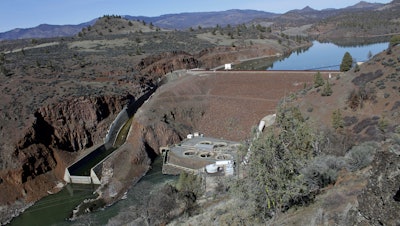
PORTLAND, Ore. (AP) — Federal regulators on Friday issued a draft environmental impact statement saying there were significant benefits to a plan to demolish four massive dams on Northern California’s Klamath River to save imperiled migratory salmon, setting the stage for the largest dam demolition project in U.S. history.
The issuing of a statement by the Federal Energy Regulatory Commission clears a major regulatory hurdle for the project and paves the way for public hearings on the document before a final draft is issued as soon as this summer.
A final environmental impact statement would allow the extensive preparations necessary for the nearly $500 million demolition and habitat restoration plan to begin in earnest. Dam removals could begin as early as next year if all goes smoothly, but a more likely scenario is 2024.
The aging dams near the Oregon-California border were built before current environmental regulations and essentially cut the 253-mile-long (407-kilometer-long) river in half for migrating salmon, whose numbers have plummeted. The project on California’s second-largest river would be at the vanguard of a push to demolish dams in the U.S. as the structures age and become less economically viable and as concerns grow about their environmental impact, particularly on fish.
Regulators wrote that moving ahead with the proposal would “maximize benefits” to salmon fisheries important to local tribes and restore the landscape to a “more natural state.”
Tribes that rely on the salmon for their sustenance and culture, including the Yurok and Karuk, cheered the milestone Friday. So did commercial fishermen and environmentalists who have worked for years to bring the dams down in a region already suffering through intense drought and dwindling water supplies.
“Our culture and our fisheries are hanging in the balance. We are ready to start work on dam removal this year," Yurok Vice Chairman Frankie Myers said in a statement.
Coho salmon from the river are listed as threatened under federal and California law, and their population has fallen by anywhere from 52% to 95%. Spring chinook salmon, once the Klamath Basin’s largest run, have dwindled by 98%.
Fall chinook, the last to persist in any significant numbers, have been so meager in the past few years that the Yurok Tribe canceled fishing last year for the first time in memory. In 2017, they bought fish at a grocery store for their annual salmon festival.
In recent years, as many as 90% of juvenile salmon sampled tested positive for a disease that flourishes when river flows are low.
“The dams are a key factor in the diseases that are wiping out entire generations of salmon,” said Glen Spain of the Pacific Coast Federation of Fishermen’s Associations.
Project proponents have thus far overcome opposition to the plan. Some local and state officials worry about flood control and residents who live around a large reservoir created by one of the dams have unsuccessfully sued to stop the project.
The dams don’t store agricultural water, aren’t used for flood control and aren’t part of the 200,000-acre (80,900-hectare) Klamath Project, an irrigation project further north that straddles the Oregon-California border.
If the dams remained, power company PacifiCorp would likely have to spend hundreds of millions of dollars to retrofit the structures to comply with today’s environmental laws. As it is, the utility has said the electricity generated by the dams no longer makes up a significant part of its power portfolio.
The original demolition proposal foundered after regulators initially balked at allowing PacifiCorp to completely exit the project.
A historic deal reached in 2020 made Oregon and California equal partners in the demolition with a nonprofit entity called the Klamath River Renewal Corporation, which will oversee the project. That deal also added $45 million to the project’s $450 million budget after concerns that the available funds weren't enough to cover any overruns.
Oregon, California and PacifiCorp, which operates the hydroelectric dams and is owned by billionaire Warren Buffett’s company Berkshire Hathaway, each provided one-third of the additional funds.
Some critics have said governors in Oregon and California were irresponsible to assume financial responsibility for cost overruns and object that part of the project is financed by a voter-approved California water bond.






















